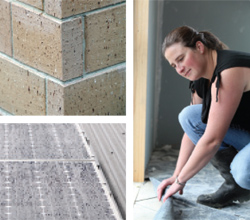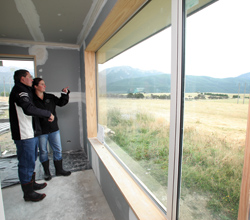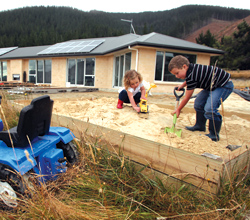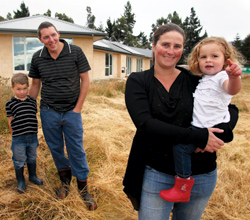Building and renovation
Country home build diary (part 4)
Greg Bruce
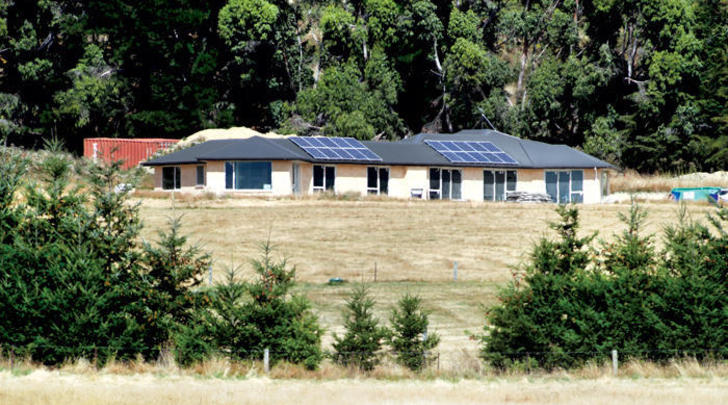
Self-sufficiency
In the final of our home build diary series, the McCrostie family – Dominique and Daryl (30 and 31) with young children Shaun (5) and Jessica (2) – are seeing the final touches go on their sustainable dream home in Marlborough. Designed by Hybrid Homes and built by Claymore Construction to a budget of $530,000, the building features:
- Rooftop rainwater collection and purifying system, with 60,000 litres of storage
- A 5kW off-grid power supply, with 20 solar panels and seven 200Ah deep-cycle lead acid batteries
- Solar hot water
- Heat-retaining concrete flooring, thermally isolated from the ground
Daryl: The only thing connected to the house is the driveway. The power comes from the sun, the water comes from the rain, the phone comes from satellite and the gas is from gas bottles which I’ll pick up as required when I come home from work. So we are fully off-grid.
Dominique: We’ve got a north-facing roof that we designed to take the solar panels. It was important when we were designing the house to have the layout we wanted, but also the roof space to have all the panels.
Daryl: The solar power supplier said the roof is the biggest clear expanse he’s worked on, without angles – just pure north-facing roof for the panels to go on. After seeing the house for the first time he’s going to get a few more panels, which will cost us, but it’s peace of mind as well.
We are going to have 20 panels now. We had originally planned for 15. It’s in keeping with the whole reason for getting solar power: It’s an initial capital outlay for long-term gain.
Dominique: There are two different types of solar panels: one for the electricity and one for the hot water. The regular solar panels are photovoltaic: they charge the batteries and the house electricity runs off that. The solar hot water has a different type of solar panel that has tubes running through it and water circulates through that.
Daryl: It’s easy to calculate how much power you’re going to generate based on sunshine hours, but the information that you’re looking at is all averages. There might be two weeks of no sun whatsoever, because of rain or thick cloud, then two weeks later there will be heaps of sunshine. But you’ve got to be aware they are averages so you’ve got to have enough storage to hold power and the ability to make more power both during the slumps and the highs.
Waste and water
Dominique: The bricks we are using are all sourced locally and all the off-cuts of the bricks get recycled. We’ve chosen to keep the off-cuts ourselves and we will use them for our own drains. We plan to crush some up and use them to make the pathway to the house. So there’s no waste from any bricks that have been cut.
Daryl: I’m up there with the builders a lot of the time and the only thing that has been leaving the site is the plastic wrapping, which they’re taking back to Nelson. They’re cutting all the wood off-cuts into firewood for us, as it’s untreated. Even the sand left over by the bricklayer will fill the kids’ sandpit.
Dominique: The roof went up and the guttering is all set up for the rainwater collection. The roof brings the rainwater into the gutters, down the drainpipes before it’s gravity-fed into the tanks. We’ll have two 30,000 litre tanks on site. And from there, it gets pumped into the house through a UV filter. It gets used for everything and is completely safe to drink.
Fitting the landscape
Daryl: It really does fit the land so well. You drive up the driveway and it’s easy to forget we started in the middle of a bare paddock; there was no driveway, no fences, nothing, just a two hectare paddock. Now we drive up the driveway that we made, alongside the fence we made, and the house just looks natural, like it should be there.
Dominique: You see a lot of houses that just look a bit out of place, a house on a ridgeline or in the middle of a field or something. They might have some gardening around them but it’s not really a part of the land. It’s separate from it. My aim was always to have a house that fits in with the land and looks like it belongs there.
